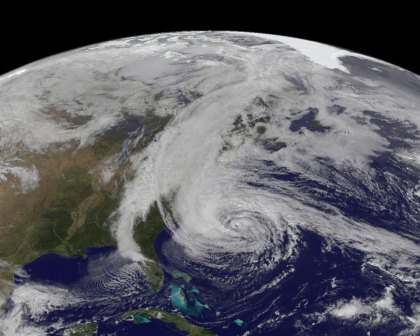Hurricane Sandy-level flooding to rise

A new study by researchers from Princeton and Rutgers universities, along with the Woods Hole Oceanographic Institution, envisions a worst-case scenario for the New York City coastline in which storm-related flooding is more frequent by 2100. The research has been published in the Proceedings of the National Academy of Sciences.
Here is the rundown:
Hurricane Sandy: The storm formed in the Caribbean on Oct. 22, 2012, according to the National Weather Service. It intensified, blasting across Jamaica, Cuba and the Bahamas. The storm headed north and by Oct. 28 had turned toward New York and New Jersey, transitioning into a post-tropical cyclone. “Because of its tremendous size, however, Sandy drove a catastrophic storm surge into the New Jersey and New York coastlines,” states a report on the storm by the National Hurricane Center. “Preliminary U.S. damage estimates are near $50 billion, making Sandy the second-costliest cyclone to hit the United States since 1900. There were at least 147 direct deaths recorded across the Atlantic basin due to Sandy, with 72 of these fatalities occurring in the mid-Atlantic and northeastern United States.”
Storm tide: Another problem with Sandy had to do with timing. The storm hit “during a particularly high astronomical tide (the tide due to the gravitational pull of Earth’s moon),” according to a Princeton University news release. “The summation of the storm surge and the astronomical tide is called the “storm tide," the total height of the floodwaters. A hurricane that produced the same size storm surge as Sandy, but that peaked during a low astronomical tide, might not cause the same catastrophic flooding.”
Examining surge floods: The scientists used computer simulations to examine past and estimate future Sandy-like flood events in New York City, the Princeton report said. They used historic data along with predictions of sea-level and storm-surge height by the National Oceanic and Atmospheric Administration. Flooding associated with coastal storms are "surge floods," water produced by a storm's pressure and wind. But the researchers also factored in sea-level rise – the increasing amount of ocean water resulting from melting glaciers and ice sheets. Taking into account sea-level rise alone, storms producing Sandy-like surge floods increased threefold from 1800 to 2000.
The future: Also examining just flooding from sea-level rise, the researchers forecast that surge floods would be more than four times more frequent between now and 2100. When predicted changes in the makeup of storms are added into the mix, “Sandy-like surge floods would become at least three times to as much as 17 times more common,” the Princeton report said.
The research: Hurricane Sandy’s flood frequency increasing from year 1800 to 2100, was led by Ning Lin, assistant professor of civil and environmental engineering at Princeton University, and published in the Proceedings of the National Academy of Sciences.
Related:
Scientist warn: Sea level rise a matter of time
Climate change could be fast, irreversible
If you would like to comment, give us a shout, or like us on Facebook and tell us what you think.

